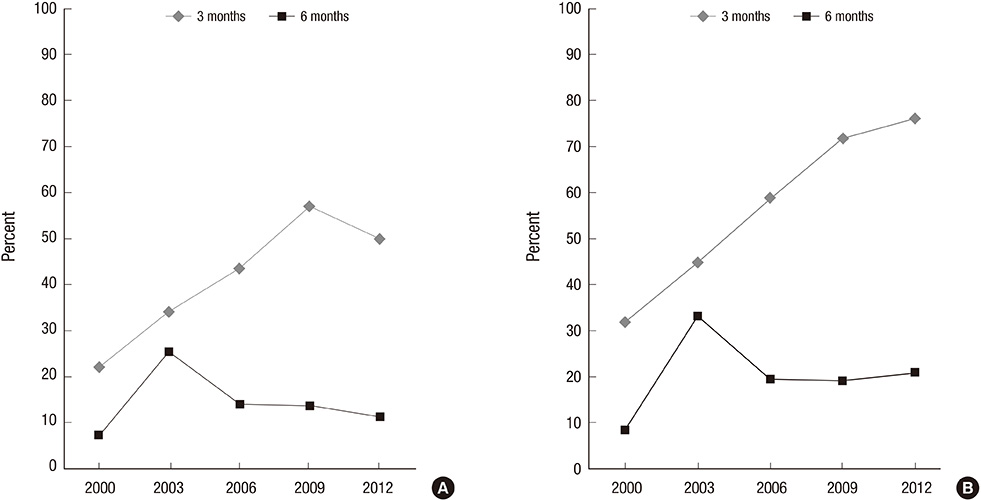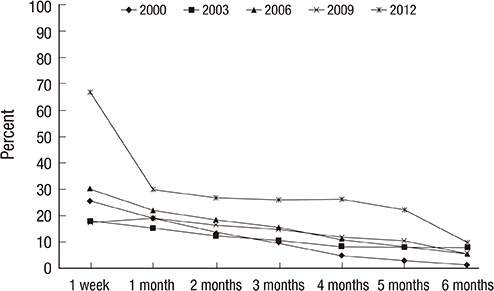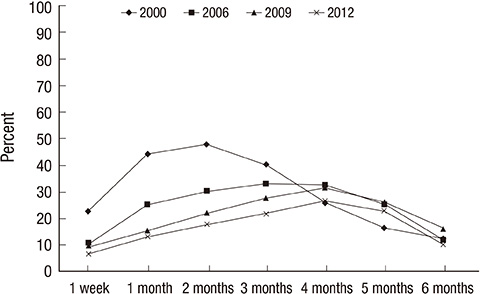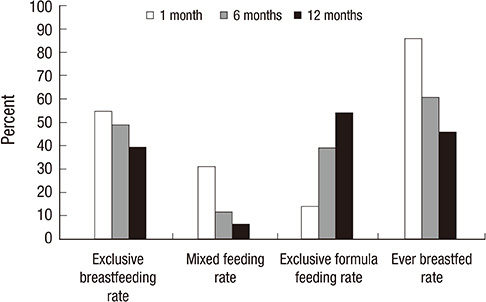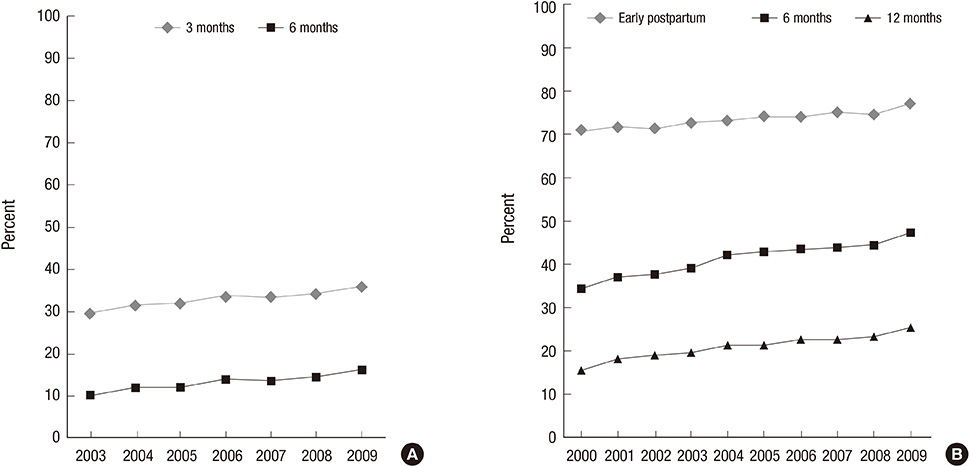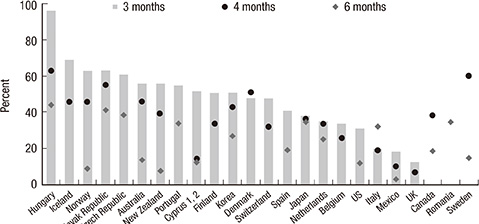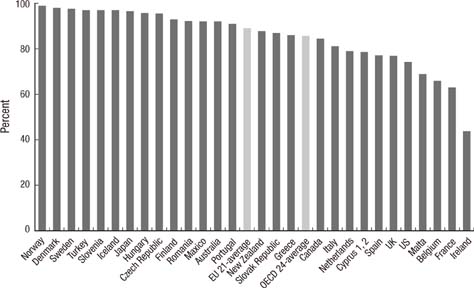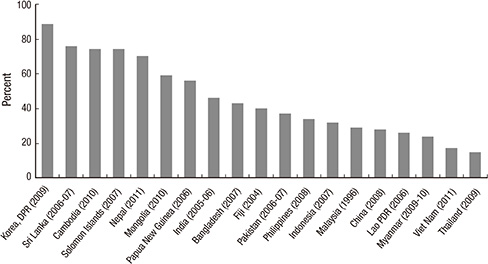J Korean Med Sci.
2013 Nov;28(11):1573-1580. 10.3346/jkms.2013.28.11.1573.
Trends of Breastfeeding Rate in Korea (1994-2012): Comparison with OECD and Other Countries
- Affiliations
-
- 1Department of Neonatology, Asan Medical Center, University of Ulsan College of Medicine, Seoul, Korea.
- 2Korea Institute for Health and Social Affairs, Seoul, Korea.
- 3Department of Pediatrics, Kyung Hee University School of Medicine, Seoul, Korea. baecw@khnmc.or.kr
- KMID: 1777652
- DOI: http://doi.org/10.3346/jkms.2013.28.11.1573
Abstract
- Breastfeeding has numerous benefits both for infants and mothers. WHO, UNICEF, and OECD report the breastfeeding rate (BR) and exclusive breastfeeding rate (EBR) at 3, 4, and 6 months of age for the international comparison. This article investigates the nationwide changes in BR and EBR in Korea from 1994 to 2012. EBR declined from 1994 to 2000, however progressively increased untill 2012. The latest data in 2012 revealed EBRs at 3, 4, and 6 months were 50.0%, 40.5%, and 11.4% respectively. The exclusive formula feeding rate (EFR) was highest in 2000 and gradually declined thereafter. In 2012, the EFRs at 3, 4 and 6 months were 21.7%, 26.5%, and 10.1%. In 2009, the EBRs at 3 and 6 months in the United States were 36.0% and 16.3% compared to 50.0% and 11.4% in Korea. In England, the EBRs were 17% and 12% in 2010. Amongst OECD countries, Hungary ranked highest EBRwith 95%, and Iceland, Norway, Slovak Republic, Australia, New Zealand followed. In conclusion, BRs were lowest in 2000, and there have been remarkable increases in BRs over the past 10 yr in Korea. Although BRs have been increasing, further efforts to increase BRs should be made continuously.
Keyword
MeSH Terms
Figure
Cited by 2 articles
-
Macronutrient composition of human milk from Korean mothers of full term infants born at 37-42 gestational weeks
Namsoo Chang, Ji A Jung, Hyesook Kim, Ara Jo, Sujeong Kang, Si-Won Lee, Hyunju Yi, Jihee Kim, Jong-Gap Yim, Byung-Moon Jung
Nutr Res Pract. 2015;9(4):433-438. doi: 10.4162/nrp.2015.9.4.433.A randomized controlled trial of pectoralis major myofascial release massage for breastfeeding mothers: breast pain, engorgement, and newborns’ breast milk intake and sleeping patterns
Won-Ryung Choi, Yeon-Suk Kim, Ju-Ri Kim, Myung-Haeng Hur
Korean J Women Health Nurs. 2023;29(1):66-75. doi: 10.4069/kjwhn.2023.03.15.
Reference
-
1. Organisation for Economic Co-operation and Development. Family databse, child outcome(CO)1.5 breastfeeding rates. accessed on 15 June 2013. Available at http://www.oecd.org/els/soc/oecdfamilydatabase.htm.2. Organisation for Economic Co-operation and Development. Breastfeeding rate, family database OECD. accessed on 15 June 2013. Available at http://www.oecd.org/els/family/43136964.pdf.3. World Health Organization. Breastfeeding health topic. accessed on 15 June 2013. Available at http://www.who.int/topics/breastfeeding/en.4. World Health Organization. Programs and projects, nutrition topics, exclusive breastfeeding. accessed on 15 June 2013. Available at http://www.who.int/nutrition/topics/exclusive_breastfeeding/en.5. United Nations Children's Fund. Nutrition, breastfeeding, recommendations for optimal breastfeeding. accessed on 15 June 2013. Available at http://www.unicef.org/nutrition/index_24824.htm.6. American Academy of Pediatrics. Section on breastfeeding: policy statement: breastfeeding and the use of human milk. Pediatrics. 2012; 129:e827–e841.7. American Academy of Pediatrics. Executive summary, 2012 breastfeeding and the use of human milk. accessed on 15 June 2013. Available at http://www2.aap.org/breastfeeding/files/pdf/Breastfeeding2012ExecSum.pdf.8. Eidelman AI. Breastfeeding and the use of human milk: an analysis of the American Academy of Pediatrics 2012 Breastfeeding Policy Statement. Breastfeed Med. 2012; 7:323–324.9. Feldman-Winter L. The AAP updates its policy on breastfeeding and reaches consensus on recommended duration of exclusive breastfeeding. J Hum Lact. 2012; 28:116–117.10. Lee WS, Cho J, Choi YS, Chung SH, Bae CW, Jung JA. Breastfeeding rate in below 6 months infants during recent 6-year in Korea based on childcare database. Neonatal Med. 2013; 20:221–227.11. Park IH, Whang NM. Survey of breastfeeding and strategic policy for improving breastfeeing in Korea. Seoul: Korea Institute for Health and Social Affairs;1994. p. 41–72.12. Kim SK, Cho AJ, Lee SS, Kim CK, Song IS. The 2000 national survey on fertility and, family health and welfare in Korea. Seoul: Korea Institute for Health and Social Affairs;2000. p. 239–247.13. Kim SK, Cho AJ, Kim YK, Park SK, Lee KW. The 2003 national survey on fertility and, family health and welfare in Korea. Seoul: Korea Institute for Health and Social Affairs;2004. p. 299–305.14. Kim SK, Cho AJ, Kim YK, Doh SR, Lee KW. The 2006 national survey on fertility and, family health and welfare in Korea. Seoul: Korea Institute for Health and Social Affairs;2006. p. 310–321.15. Kim SK, Kim YK, Cho AJ, Kim HR, Lim SE. The 2009 national survey on fertility and, family health and welfare in Korea. Seoul: Korea Institute for Health and Social Affairs;2009. p. 282–294.16. Kim SK, Kim YK, Kim HR, Park CS, Shon SK, Choi YJ, Kim YW, Lee GE, Yoon AR. The 2012 national survey on fertility and, family health and welfare in Korea. Seoul: Korea Institute for Health and Social Affairs;2012. p. 415–441.17. Korea Ministry of Health and Welfare and Korea Centers for Diseases Control and Prevention. Korea national health and nutrition examination survey in 1998, 2001, 2005, 2007-2009, and 2010-2012. accessed on 15 June 2013. Available athttp://www.cdc.go.kr.18. Centers for Disease Control and Prevention USA. Breastfeeding, breastfeeding report card - United States 2012. accessed on 15 June 2013. Available at http://www.cdc.gov/breastfeeding/data/reportcard.htm.19. Centers for Disease Control and Prevention USA. Breastfeeding. accessed on 15 June 2013. Available at http://www.cdc.gov/breastfeeding/data/NIS_data.20. UK National Statistics, Information Center for Health and Social Care. Infant feeding Survey-UK, 2010, incidence, prevalence and duration of breastfeeding. accessed on 15 June 2013. Available at https://catalogue.ic.nhs.uk/publications/public-health/surveys/infant-feed-surv-2010/ifs-uk-2010-chap2-inc-prev-dur.pdf.21. OECD/WHO. Breastfeeding in Health at a Glance: Asia/Pacific 2012, OECD Publishing. accessed on 15 June 2013. Available at http://www.oecd-ilibrary.org/social-issues-migration-health/health-at-a-glance-asia-pacific-2012/breastfeeding_9789264183902-18-en.22. Kim HR. Trends of breastfeeding in Korea and other nations: strategic policy for improving breastfeeing in Korea. Issue Focus. 2011; 86:1–8.
- Full Text Links
- Actions
-
Cited
- CITED
-
- Close
- Share
- Similar articles
-
- Comparison of Nursing Workforce Supply and Employment in South Korea and Other OECD Countries
- Trends in National Pharmaceutical Expenditure in Korea during 2011 - 2020
- Lessons from Using Opioid to the Treatment of Chronic Pain: Focus on Experiences with the Organization for Economic Cooperation and Development Countries
- A Comparative Study of Suicide Rates among 10–19-Year-Olds in 29 OECD Countries
- Position Value for Relative Comparison of Healthcare Status of Korea in 2014


